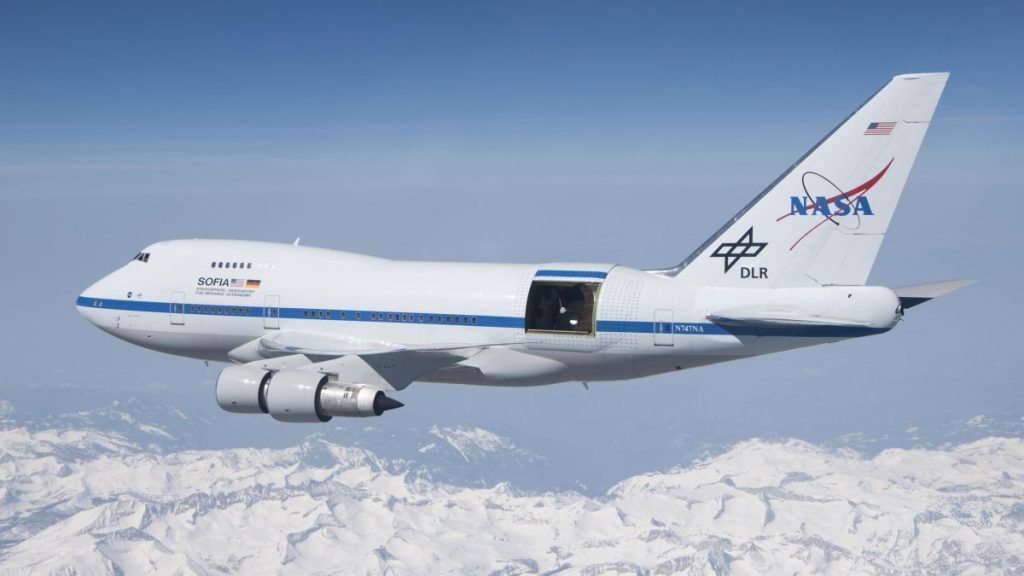
NASA’s flying telescope is coming to the end of its mission but leaves a strong science legacy (Image Credit: Space.com)
Most telescopes here on Earth are stationary, bound to a single location, often in a desert or on a mountain peak. But NASA’s Stratospheric Observatory for Infrared Astronomy (SOFIA) isn’t most telescopes.
SOFIA, for which NASA partnered with the German space agency (DLR), is a flying observatory. More specifically, it’s a Boeing 747SP aircraft with a massive hole in its size, through which a 106-inch (2.7-meter) telescope takes in infrared views of the universe. SOFIA’s 10-hour flights at 38,000 to 45,000 feet (about 11,500 to 13,700 meters) meant its instruments had to observe through much less of Earth’s atmosphere, which blocks infrared light.
SOFIA began regular operations in 2014 and since then has been cruising through the night skies around the world, looking at the cosmos, but its last science campaign was scheduled to conclude Wednesday (Sept. 28). The campaign marks the end of the observatory’s three-year mission extension. Soon, it will be decommissioned, per the recommendation of the most recent astrophysics decadal survey, a document in which scientists evaluate research priorities for the next 10 years.
Related: Photos from SOFIA, NASA’s flying telescope (gallery)
“Equipped with exceptionally talented and diverse teams of scientists, engineers and aviation experts, SOFIA accomplished a wide variety of scientific achievements that will have a lasting impact on our understanding of many aspects of astrophysics, from galactic evolution, star formation and planetary science,” SOFIA project scientist, Naseem Rangwala of NASA’s Ames Research Center in California, which managed the science aspects of the mission, told Space.com. “The professionalism, creativity and resilience of the SOFIA team, scientists and engineers, was best demonstrated during the most difficult and challenging phase of the COVID-19 pandemic.” During that period, the team safely managed two international deployments.
We’re taking a look back at some of SOFIA’s most memorable discoveries during its eight years of service.
Discovering water in sunlit areas on the moon
In 2020, scientists announced that they had detected trace amounts of water in sunlit areas of the moon‘s Clavius Crater using SOFIA data. “Previously there were indications from other missions of presence of water on the sunlit part of the moon, but SOFIA was able to confirm it unambiguously by detecting a spectral feature unique to water molecules,” Rangwala said. SOFIA has continued to study the moon since and recently discovered water in the moon’s Moretus Crater.
It’s not a lot of water — by comparison, the Sahara desert here on Earth has 100 times more water than what SOFIA saw in the Clavius Crater. Still, the water’s presence could have implications for future NASA moon missions, including the VIPER rover, due to launch in 2024 to sniff out water ice at the lunar south pole, and the Artemis program to return astronauts to the moon for the first time since 1972.
Measuring oxygen in Earth’s upper atmosphere
SOFIA also did science closer to home. The mesosphere and lower thermosphere are some of the least understood parts of Earth’s atmosphere. In 2021, SOFIA’s German Receiver for Astronomy at Terahertz Frequencies (GREAT) instrument measured atomic oxygen in these regions of the upper atmosphere. The work has contributed to scientists’ research into the exchange of solar energy between space and the Earth’s surface.
“The researchers provided a critical constraint on the temperature of the mesosphere and lower thermosphere using these measurements,” Rangwala said. “This represents a critical contribution to climate change models which rely on these temperature measurements to understand Earth’s climate change.”
Magnetic fields across the universe
“One of SOFIA’s enduring legacies is surely the SALSA program that observed cosmic magnetic fields in many nearby galaxies,” Rangwala said. “Unlike other observatories, SOFIA has an unparalleled spatial resolution for these studies, and [it] observed fine details that were otherwise unattainable.”
The SALSA program, more formally known as the Survey on Extragalactic Magnetism with SOFIA, made numerous discoveries over the course of SOFIA’s mission. For starters, the program has determined that all galaxies have magnetic fields in their interstellar mediums. But it’s also discovered that the magnetic fields of recently-merged galaxies, such as Centaurus A, are “amplified and highly turbulent.”

Recently, SOFIA also examined the magnetic fields of a galaxy called NGC 1097. “These observations show that magnetic fields play a key role in spoon-feeding matter from the spiral arms and starburst ring into the black hole itself,” Rangwala said. “This study is an important part of SOFIA’s legacy as an example of how astronomers are unraveling the interplay between gravity and cosmic magnetic fields in galactic evolution.”
Discovering the first molecule
Cosmologists believe that the first molecule to form in the universe after the Big Bang was helium hydride, a combination of helium and hydrogen, which formed as the universe cooled. But despite that theory, astronomers could find no trace of the molecule anywhere in the cosmos, even in regions that mimic the environment of the early universe. Until they used SOFIA, that is.
“SOFIA’s GREAT instrument is a highly sensitive, high-resolution spectrometer that could, in theory, make a detection of helium hydride in our modern universe, but first it needed an upgrade,” Rangwala said. “GREAT’s team of scientists and engineers designed such an upgrade that allowed them to make the first ever detection of helium hydride in the modern universe, supporting the theories of the early universe.”
Follow Stefanie Waldek on Twitter @StefanieWaldek. Follow us on Twitter @Spacedotcom and on Facebook.





